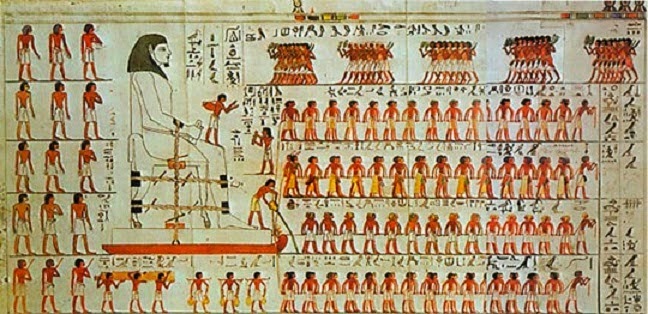Più la superficie di sabbia risultava rigida e minore era lo sforzo necessario per trainare la slitta.
Esistono disegni tombali egizi (vedi figura, sotto) in cui appare chiaramente la rappresentazione dell'esistenza di questa tecnica.
Egyptians moved pyramid stones over wet sand
Physicists from the FOM Foundation and the University of Amsterdam have discovered that the ancient Egyptians used a clever trick to make it easier to transport heavy pyramid stones by sledge.
The Egyptians moistened the sand over which the sledge moved.
By using the right quantity of water they could halve the number of workers needed. The researchers published this discovery online on 29 April 2014 in Physical Review Letters.
Average core blocks of the Great Pyramid weigh about 1.5 tons each, and the granite blocks used to roof the burial chambers are estimated to weigh up to 80 tons each [Credit: Mgiganteus1/WikiCommons]
For the construction of the pyramids, the ancient Egyptians had to transport heavy blocks of stone and large statues across the desert.
The Egyptians therefore placed the heavy objects on a sledge that workers pulled over the sand.
Research from the University of Amsterdam has now revealed that the Egyptians probably made the desert sand in front of the sledge wet.
Experiments have demonstrated that the correct amount of dampness in the sand halves the pulling force required.
Firm sand The physicists placed a laboratory version of the Egyptian sledge in a tray of sand. They determined both the required pulling force and the stiffness of the sand as a function of the quantity of water in the sand.
To determine the stiffness they used a rheometer, which shows how much force is needed to deform a certain volume of sand.
A large pile of sand accumulates in front of the sledge when this is pulled over dry sand (left). On the wet sand (right) this does not happen
[Credit: Fundamental Research on Matter (FOM)]
Experiments revealed that the required pulling force decreased proportional to the stiffness of the sand. Capillary bridges arise when water is added to the sand. These are small water droplets that bind the sand grains together.
In the presence of the correct quantity of water, wet desert sand is about twice as stiff as dry sand.
A sledge glides far more easily over firm desert sand simply because the sand does not pile
up in front of the sledge as it does in the case of dry sand.
Wall painting
The Egyptians were probably aware of this handy trick.
A wall painting in the tomb of Djehutihotep clearly shows a person standing on the front of the pulled sledge and pouring water over the sand just in front of it.
Wall painting from the tomb of Djehutihotep showing a large statue is being transported by sledge. A person standing on the front of the sledge wets the sand
[Credit:: Al-Ahram Weekly/Fundamental Research on Matter (FOM)]
Besides revealing something about the ancient Egyptians, the results are also interesting for modern-day applications.
We still do not fully understand the behaviour of granular material like sand.
Granular materials are, however, very common.
Other examples are asphalt, concrete and coal. The research results could therefore be useful for examining how to optimise the transport and processing of granular material, which at present accounts for about ten percent of the worldwide energy consumption.
Author: Ans Hekkenberg
| Source: Fundamental Research on Matter (FOM) [April 30, 2014]
Read more at: http://archaeologynewsnetwork.blogspot.it/2014/04/egyptians-moved-pyramid-stones-over-wet.html?utm_source=feedburner&utm_medium=feed&utm_campaign=Feed:+TheArchaeologyNewsNetwork+(The+Archaeology+News+Network)#.U2H6Nyh7DfX
Follow us: @ArchaeoNewsNet on Twitter | groups/thearchaeologynewsnetwork/ on Facebook


